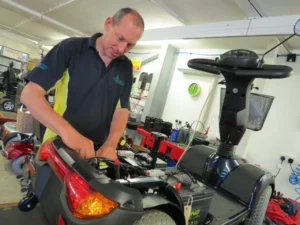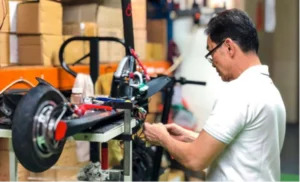The scooter battery is the heart of your scooter, powering your journey and ensuring that you can rely on your device for your daily activities. By 2024, most e-scooters will have either sealed lead acid (SLA) or lithium-ion batteries. Knowing what type of battery your scooter uses is the first step to knowing how to repair or maintain it. SLA batteries are more traditional and require regular charging and occasional maintenance, while lithium-ion batteries last longer and require less maintenance. However, over time, both types of scooters can experience issues that require repairs to keep the scooter running smoothly.
Diagnosing Battery Problems
Before attempting a repair, it is crucial to diagnose the exact problem with your battery. Common issues include a power outage, a battery that won’t charge, or the scooter unexpectedly turning off. By 2024, many scooters will come with diagnostic tools or apps that can help you identify issues. If your scooter has this feature, use it to check for error codes or battery status indicators. If not, you can manually check for common signs of battery failure, such as swelling, leakage, or corrosion of the terminals. Understanding the specific problem will help you determine the appropriate solution.
Repair Corroded Battery Terminals
Corrosion of the battery terminals is a common problem, especially with SLA batteries. Corrosion of the terminals can prevent the battery from charging properly or cause intermittent power outages. To repair corroded terminals, disconnect the battery from the scooter. Once removed, clean the terminals with a mixture of baking soda and water and gently scrub the corrosion away with a brush. After cleaning, make sure the terminals are completely dry before reconnecting the battery. By 2024, you’ll also find corrosion-resistant terminal covers that help prevent this problem from happening again, making them a good investment in extending the life of your battery.
Recovering a Deeply Discharged Battery
One of the most common problems with scooter batteries is deep discharge, where the battery is drained beyond the recommended level. This can happen if the scooter is left unused for an extended period of time or if the battery is not charged regularly. By 2024, some advanced chargers will be designed to recover deeply discharged batteries by gradually restoring the charge over time. If you don’t have one of these chargers, you can try recovering the battery by connecting it to a standard charger and charging it for an extended period of time (usually up to 24 hours). However, if the battery does not respond or hold a charge after this, it may need to be replaced.
Repair or Replace the Battery
With lithium-ion batteries, individual cells in the battery pack sometimes fail, causing the total battery capacity to be lost. Repairing these batteries can be more complicated, but it is possible if you are familiar with electronics. First, you will need to use a multimeter to identify the faulty battery. Once the faulty battery has been identified, it can be removed and replaced with a new battery of the same type. It is important to note that working with lithium-ion batteries can be dangerous due to the risk of short circuits and fires, so if you are not experienced in this type of repair, it may be safer to seek professional help. Battery repair services are becoming increasingly accessible in 2024, with many technicians offering to replace a faulty battery for a fee, saving you from having to buy a whole new battery.
Balanced lithium-ion battery
Cell imbalance is a common problem with lithium-ion batteries, causing your scooter to lose power quickly or not fully charge. Balancing the cells ensures that each cell in the battery pack has the same voltage level, maximizing the efficiency and lifespan of the battery. To balance your cells, you can use a battery management system (BMS), which automatically monitors and equalizes the voltages of all cells. In 2024, many scooters will be equipped with a built-in BMS, but if your scooter does not have this feature, you can use an external BMS device. Balancing your battery regularly can prevent many problems and extend the life of your battery.
Replace a defective battery management system (BMS)
The battery management system (BMS) is crucial to the health and safety of lithium-ion batteries, as it monitors the charge, discharge, and temperature of the battery energy is beyond repair or if multiple cells have failed, replacing the entire battery pack may be the best option. In 2024, battery packs are widely available and come in various capacities and types. When replacing your battery pack, ensure that the new one is compatible with your scooter model. It’s also a good opportunity to consider upgrading to a higher-capacity battery if you need more range or if you’ve been using your scooter more frequently. Installation is usually straightforward, but if you’re unsure, it’s advisable to have it installed by a professional to avoid any potential issues.
Proper Battery Disposal
After replacing or repairing your battery, it’s essential to dispose of the old battery properly. Batteries contain hazardous materials that can harm the environment if not disposed of correctly. In 2024, many communities offer battery recycling programs where you can safely dispose of old batteries. Never throw batteries in the trash or leave them where they could be a hazard. By properly disposing of your old battery, you contribute to environmental conservation and comply with local regulations regarding hazardous waste.
Maintaining Your Battery After
Repairs Once you’ve repaired or replaced your battery, maintaining it is crucial to prevent future issues. By 2024, the best practices for battery maintenance include regular charging, avoiding deep discharges, and storing the scooter in a cool, dry place. If you plan to store your scooter for an extended period, charge the battery to about 50% and disconnect it to prevent it from discharging completely. Regularly inspect the battery for any signs of wear or damage and clean the terminals as needed. By following these maintenance tips, you can extend the life of your battery and ensure your mobility scooter remains reliable.
Conclusion
Repairing mobility scooter batteries in 2024 involves a mix of traditional techniques and modern technology. Whether you’re dealing with corroded terminals, a deeply discharged battery, or a faulty cell, understanding how to diagnose and address these issues can save you money and keep your scooter running smoothly. However, always prioritize safety, and don’t hesitate to seek professional help for more complex repairs.


